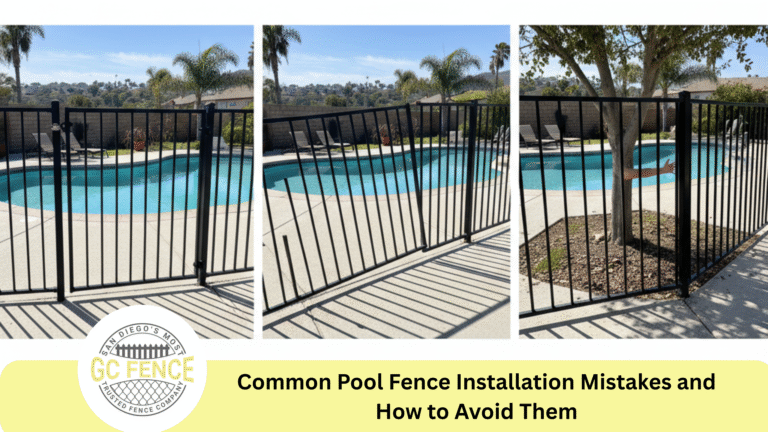San Diego’s warm climate and year-round outdoor lifestyle make backyard pools extremely popular. But with that popularity comes a responsibility, ensuring your pool area is safe and compliant with California safety regulations. One essential component of pool safety is a properly installed pool fence. Many homeowners attempt DIY installations or hire inexperienced installers, only to run into costly mistakes later.
Below are the most common pool fence installation mistakes in San Diego and expert tips on how to avoid them.
1. Not Following California & San Diego Safety Codes
California has strict pool safety laws, and San Diego County enforces them carefully to prevent accidents, especially involving children. Common mistakes include:
- Installing fences shorter than the required 60 inches
- Allowing too much space between fence panels
- Not using self-closing and self-latching gates
- Skipping door or window alarms leading to the pool area
How to Avoid It:
Always review California Swimming Pool Safety Act requirements before installation. Work with a licensed professional familiar with local building codes and regional enforcement practices.

2. Choosing the Wrong Fence Material for Coastal Conditions
San Diego’s coastal climate can be tough on certain materials. Salt air, humidity, and intense UV exposure can damage low-quality fencing.
Common Mistakes:
- Selecting metal that rusts quickly
- Choosing a mesh that tears or loosens
- Using inexpensive vinyl that warps in the sun
How to Avoid It:
Choose materials designed for coastal environments, such as powder-coated aluminum, glass, or high-quality UV-resistant mesh. Professionals can recommend the best choice based on whether you’re inland or near the coast.
3. Improper Fence Height or Gap Spacing
Even when homeowners use strong materials, installation errors often compromise safety.
Mistakes Include:
- Fence panels installed unevenly
- Large gaps underneath the fence
- Posts spaced too far apart, causing flex or sag
These create opportunities for pets or small children to slip through.
How to Avoid It:
Ensure your fence maintains a consistent height of at least 60 inches with minimal ground clearance. Correct post spacing ensures the structure stays rigid.
4. Poor Gate Placement and Low-Quality Hardware
A pool fence is only as secure as its gate. Many DIY installers underestimate the importance of correct placement and hardware selection.
Common Mistakes:
- Installing gates that swing inward toward the pool
- Using manual locks instead of self-closing/self-latching mechanisms
- Placing the gate in a hard-to-see or unsafe entry point
How to Avoid It:
Gate placement should provide visibility, quick access in emergencies, and meet legal requirements. Always choose durable, corrosion-resistant hardware designed specifically for pool safety.
5. Uneven Ground or Sloped Yard Misalignment
San Diego’s diverse topography includes sloped yards, uneven patios, and terraced landscaping. Installing a pool fence without adjusting for grade changes leads to gaps, loose posts, and unsafe leaning fences.
How to Avoid It:
Professionals survey the land, measure grade variations, and use stepped or racked fence systems so the fence aligns naturally with the terrain.

6. Ignoring Soil Type and Post Stability
Areas of San Diego, especially near the coast, have sandy or shifting soil. If posts are not anchored deeply or properly set in concrete, the fence becomes unstable over time.
Signs of Poor Installation:
- Wobbling posts
- Leaning fence sections
- Cracked or loose concrete footings
How to Avoid It:
Use deep post-holes with strong concrete footings. In sandy areas, professionals may add stabilizers to reinforce the base.
7. Blocking Emergency Access Areas
Some homeowners unintentionally place fences in areas that interfere with emergency pathways or access to equipment like pool pumps and electrical panels.
Consequences Include:
- Difficulty cleaning or maintaining the pool
- Obstructed emergency entry points
- Violations during inspections
How to Avoid It:
Map out access areas before installation. Your fence should protect the pool without obstructing essential pathways.
8. Choosing Style Over Safety
San Diego homeowners love stylish backyards, but aesthetics alone often lead to safety compromises.
Examples:
- Using decorative gates without self-latching locks
- Choosing glass panels with poor shatter resistance
- Prioritizing looks over structural support
How to Avoid It:
Choose a fence that balances style and safety. Modern options, like frameless glass or sleek aluminum, can deliver both.
9. Attempting DIY Installation Without Expertise
While DIY pool fence kits may look simple, mistakes during installation can lead to major safety risks and code violations.
DIY Challenges:
- Inaccurate measurements
- Incorrect drilling or anchoring
- Poor alignment and stability
- No knowledge of local codes
How to Avoid It:
If safety and compliance matter, hire a licensed professional. They ensure every part of the fence, from height to hardware, meets San Diego standards.
10. Not Performing Routine Inspections After Installation
Even a well-installed pool fence requires regular checks, especially in high-use backyards or areas exposed to wind and salt.
Commonly Missed Issues:
- Loose posts or hinges
- Rust or corrosion
- Torn mesh
- Misaligned gates
How to Avoid It:
Schedule annual inspections with a pool safety contractor and perform monthly homeowner checks.

Call to Action
Pool fence installation isn’t just a visual upgrade; it’s a critical safety measure that protects children, pets, and guests. Understanding these common mistakes helps you avoid costly repairs, failed inspections, or unsafe conditions. For the best results, work with an experienced pool fence installer who knows San Diego’s regulations and environmental factors. Call to Action!


